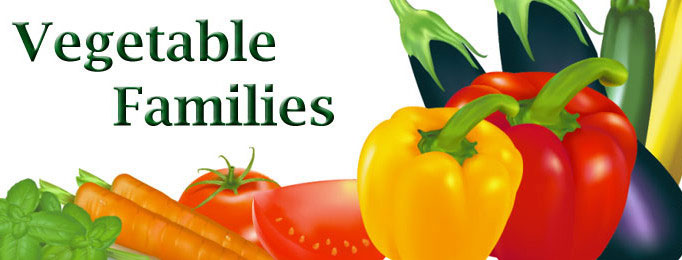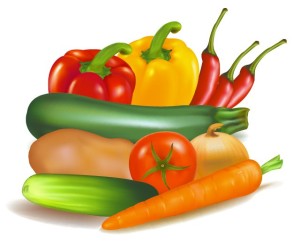Getting to Know the Vegetable Families Makes it Easier to Plan Ahead
Planning, planting and growing a vegetable garden does not require that you know everything there is to know about vegetables but it does help to know the various families and groups of vegetables as there are some general rules which apply to each family and how they get along with each other.
Historically, the art of understanding plant relationships, known as companion planting vegetables, goes back centuries. Unfortunately, modern science has not kept up with this ancient interest. New and innovative gardening approaches have recently rediscovered and begun expanding and documenting this useful ancient practice.
Once you know the vegetable families it’s much like knowing how to ride a bicycle: you may not ride every day but you know the basic requirements and you can get on and ride anytime the occasion comes up; you won’t fall off.
A Basic Knowledge of the Vegetable Families Provides a Lot of Helpful Information
Knowing the vegetable families you will know without thinking about it too much who needs a male and female flower to pollinate, who adds nitrogen to the soil, who is related to whom and in general how they get along (or don’t) with each other.
You may not remember all member of all families, but you will know, for example, if it is a squash or a melon or a gourd that it is a member of the cucurbits family and that means it doesn’t like those guys over in the potato patch.
Vegetable Families can be Like Human Families
Of course no rules hold true 100%; and plants are no exception. Some members of the family are just shunned by everyone, even when the rest of the family gets along fine with lots of other families.
Eccentric and Grumpy Relatives in the Mix
Think of them as the odd cousins, or the eccentric maiden aunts or crotchety bachelor uncles in the group. Fennel is one of these, for instance, being pretty well offensive to just about everyone in the vegetable garden and should be planted by itself, under an apple tree, or, according to folklore, near the dog kennel as it deters fleas. It does attract good beneficial insects, so it’s a good plant to grow, just not in the vegetable garden, please.
Now, Fennel is a member of the Umbelliferae family – think of umbrellas, like Queen Anne’s Lace flowers, one of the hereditary members of this plant family who still exists today. The other common vegetable members of this family are celery, carrot, dill, chervil, cilantro, parsley, and parsnip.
One Crotchety Relation Does Not a Family Make
Interestingly, fennel, the crotchety old bachelor uncle, is the uncle of carrot, one of the sweet maidens of the vegetable garden who can go in just about anywhere and add benefit to her neighbors. So, just like people, you cannot judge a family by only one of its members.
Beneficial Cousins – Companion Planting Vegetables
Dill, another cousin of Fennel, is the only plant that can grow next to it without falling deathly ill and passing on to the great beyond. Dill is also is a great boon to cucumbers, lettuce, onions, cabbage and corn but can cause problems for tomatoes and carrots. On the other hand, dill is one of the most powerful beneficial insect attractors; they will flock to its blooms and seed heads.
Dill leaves are a natural repellant for squash bugs, which kill squash vines. Just break the dill leaves off and into pieces and scatter them among the squash leaves. So, as you can see, this family derived from the wild flower Queen Anne’s Lace may be crotchety but they are also extremely helpful if used properly.
The chart below is as near to complete a list of the vegetables in their proper families as possible, based on compiling several sources we have been using over the years so no one is left out.
Crop Rotation, Vegetable Families, Annuals and Perennials
Note that most lists are incomplete, as they are created for the purpose of advising on crop rotation by family among different vegetable beds each year. This way each family returns to their starting bed once every four years. We do not believe this is an absolutely essential practice, although we do rotate crops. But if you want to rotate crops specifically and in the four-bed four-year cycle now you have a complete list to guide you.
Because this is why most people make the list, they leave out the perennials (perennials do not get rotated as they stay put and continue to grow from one year to the next), while most of the major vegetable family members are annuals and so must be replanted each year. Favorite perennials are rhubarb, asparagus, sorrel, artichoke and okra (in warmer southern climates).
Most herbs, with a few exceptions such as chamomile and basil are also perennials. There are definite affinities between perennial herbs and vegetables, and for many gardeners this means that some plants that might be rotated are not when their perennial herb partners are fixed and other beneficial perennials are there to help support them. Tomatoes and asparagus, parsley, rosemary and mint all work together this way, and the basil (another helper herb for tomato) is planted with the tomatoes each year.
The plant families in this chart include some of the perennials not found in other charts. Our feeling is it is helpful to know who is related to whom, and even if they are not being rotated, the relationships are useful to be aware of.
| Family | Vegetables in Family |
| Onion/Allium Family (Alliaceae/Amaryllidaceae) |
chives, garlic, garlic chives, elephant garlic, leeks, onion, scallions, shallot |
| Cabbage /Crucifer/ Mustard Family (Brassicaceae /Cruciferae) |
bok choi, broccoli, broccoli raab, brussels sprouts, cabbage, calabrese, cauliflower, chinese cabbage, collards, cress, daikon, horseradish, kale, kohlrabi, mustard, radish, rutabaga, swede, tatsoi, turnip, wasabi, watercress |
| Beetroot /Goosefoot Family (Chenopodiaceae /Amaranthaceae) |
amaranth, beet, beetroot, chard, good king henry, goosefoot, lamb’s quarters, pigweed, quinoa, spinach, sugar beet, swiss chard (spinach beet) |
| Aster/Daisy Family (Asteracea/Compositae) |
artemisia, cardoon, chamomile, chicory, chrysanthemums dandelion, endive, escarole, globe artichoke, jerusalem artichoke, lettuce, marigolds, safflower, salsify, scorzonera, shungiku (edible chrysanthemum), sunflower, tarragon |
| Squash/Cucurbit Family (Cucurbitaceae) |
cucumber, gourds (angled luffa, bitter gourd (balsam pear, bitter melon), hardshelled gourd, smooth luffa, snake gourd), melons (cantaloupe/muskmelon, casaba, honeydew melon, water melon), squash/marrow (acorn, banana, buttercup, butternut, cheese, crookneck, delicata, golden cushaw, hubbard, kabocha, pumpkin, scallop, spaghetti, zucchini/courgette), west indian gherkin |
| Bean and Pea Family (Fabaceae/ Leguminosae) |
alfalfa, beans (adzuki bean, broad bean, chickpea/garbanzo bean, fava bean, french bean, hyacinth bean, lima bean, mung bean, rice bean, runner bean, soybean, vigna mungo), clover, cowpea, fenugreek, lentil, lupin, peas, peanuts, tares/vetches, trefoil |
| Potato/Nightshade Family (Solanaceae) |
eggplant (aubergine), garden huckleberry, peppers (caribbean red hot peppers, chili pepper, habanero, hot paper lantern, sweet pepper), paprika, potato, tobacco, tomato, tomatillo/husk cherry |
| Carrot Family Umbelliferae/Apiaceae) |
caraway, carrot, celery, celeriac, chervil, coriander/cilantro, cumin, dill, fennel, parsley, parsnip, root parsley |
| Grasses Family (Poaceae/Gramineae) |
barley, corn/maize, mallet, oats, rice, rye, sorghum, sugarcane, wheat |
| Miscellaneous | lambs lettuce (Valerianaceae); new zealand spinach (Aizoaceae); purslane, portulaca, miners lettuce (Portulacaceae); rhubarb, buckwheat (Polgonaceae); Okra (Mallow family, Malvaceae, cacao is also in this family); phacelia; grazing rye |
A Brief Overview and Introduction to each of the Families:
Onion/Allium Family (Alliaceae/Amaryllidaceae)
This family needs good drainage and loose sandy loamy soil. They can start early and go late as they are cold-hardy and like cool weather. Grow the members of the onion family according to your latitude: there are short and long day varieties (short for the South, long for the North) and they don’t do well in the wrong place. The dividing line is right around 36 degrees latitude (Virginia Beach to San Francisco). Most onion pest problems can be avoided with lots of organic matter and very well-draining loose loamy sandy soil in the vegetable beds.
Cabbage /Crucifer/ Mustard Family (Brassicaceae /Cruciferae)
All the members of this family prefer fertile soil, and good mulching is essential to keeping them cool and moist. They are greedy for their space and will provide poor crops if too crowded, yielding small heads and stunting.
In many areas the cabbage family is grown as a spring and fall crop, planting before the last frost in Spring and again in August or September for an after-frost harvest. Frost tends to sweeten many of these, most especially the kales.
Beetroot /Goosefoot Family (Chenopodiaceae /Amaranthaceae)
This is another family which does well in cool weather. Multiple plantings throughout the cool spring and again in late summer will give continual production. These plants, especially the spinach and chard can tend to bolt in hot weather and may need to be kept cooler or planted in shadier areas in mid-summer. Plants need uniform temperature and humidity, a thick straw mulch does a good job for this reason.
Aster/Daisy Family (Asteracea/Compositae)
While it may seem wild to figure out how this family is related when it comes to planting and culture, they all do consistently require good sunny locations and fertile soil with lots of organic matter and consistent watering. They are also all susceptible to varying degrees to root disturbance and so are either best direct seeded or transplanted no more than four weeks after starting so as to ensure roots have not outgrown their starter pot and can be slipped into the garden without disturbance to the roots.
Artichokes are a warm weather perennial vegetable and may not do well in hard cold climates although they can be overwintered in cooler zones by cutting back large arms in fall and covering with leaves, straw or other dry bedding piled up all around and tied in place with loose fence boards or by placing an inverted bushel basket over the top.
Squash/Cucurbit Family (Cucurbitaceae)
A warm climate loving family, these plants should be planted out in warm soil. Transplants planted before soil is warm will rot. Large melons or other large fruit members of this family can be trellised to save space but the large fruits must be supported to avoid breaking off before mature.
Regular watering especially during early growth and as vines blossom and set fruit is essential. Allowing these plants to dry out and wilt during fruit set or early fruit growth can result in stunted bitter fruits. Once fruits are set, watering can be lessened as fruits reach full maturity. Fruits not set in time will not mature before frost and will stop growing when chilled.
The members of this family need warmth, sun and consistent water to do well. This family, when grown in close proximity, can cross-pollinate prolifically among its subgroup members. What that means: Gourds will cross with other gourds. Squash will cross with other squashes. Melons will cross with other melons. While cucumbers and melons will not cross with the squashes; pumpkins, gourds and squashes have been known to cross. Read more about cross pollination in the cucurbit family. Seed saving for this family in home gardens is not recommended. Powdery mildew can develop in shade, too much wet, especially on leaves late in the day, or in high humidity. Remove any severely damaged leaves, spray with a mix of 1 part milk, 1 part baking soda and 10 parts water to kill mildew.
Bean and Pea Family (Fabaceae/ Leguminosae)
There are two groups in this family: early/cool and late/warmer longer season. Peas and fava beans are early cool crops and can be planted as soon as the ground can be worked, with many gardeners starting peas well before the last frost date. Succession plantings of peas every two weeks in a morning sun location can provide peas all season.
This is the nitrogen fixing family and its members harvest nitrogen from the air and store it in the soil through root nodes. Great early crop before corn and other heavy nitrogen feeders (grains etc.) These plants will not do well if roots are disturbed and most are direct-seeded into the ground.
When thinning, cut to remove excess plants rather than pulling up to avoid disturbing neighboring roots. Harvest peas frequently to generate more peas, and harvest beans as soon as they mature to get continued crops. Mature beans left on the vine will halt production. Do not harvest wet beans as this can lead to diseases in the plant being spread.
Potato/Nightshade Family (Solanaceae)
All of the members of this family except for potatoes should be started as seedlings indoors or in greenhouses starting 8 to 10 weeks before the last frost date. Tomatoes may be started a few weeks later, but if started early and growing leggy, simply plant deeper so the stalk is submerged to leave only the crown of the plant above ground. The lower leaves should be snipped off leaving a bit of stem, they will become roots.
All members of this family except potatoes also need warm soil to be planted out. Potatoes can be started earlier in spring, as seed potatoes. Mulching is critical for potatoes which must be hilled up and covered as they grow. The leaves and stems will produce the potatoes when covered. Potatoes exposed to sunlight turn green and cannot be eaten. All members of this family need good full sun at least six to eight hours a day and well fertilized soil. All do well with a mulch to maintain even temperature and moisture.
Support is critical for all members of this family as well: tomatoes, eggplants and peppers need good support to hold heavy fruit. Better to over-support than under-support as heavy fruits will not only fall but break the plant branches which hold them. Potatoes are supported by the hilling up of soil and organic matter around the plants to block sun and hold branches in place as potatoes set.
Carrot Family (Umbelliferae/Apiaceae)
Most members of this family produce their edible portion underground and so need a loose, deep, well-drained and fertile soil to thrive. Most members of this family are direct-seeded in the garden. Carrots, parsley, dill, cilantro, fennel, and chervil being the cool weather members, are the first to plant, usually six to eight weeks before the last frost. These plants need regular watering when germinating so water every day if it does not rain. Germination can take up to three weeks. These can also all be seeded again in August for a late season crop.
Proper thinning is essential for good production of the below ground crops, and thinning can be done by pulling young plants for early harvest. Celery and celeriac can be pre-seeded in the greenhouse or indoors, but must be transplanted out before becoming rootbound. Parsnips, celery and celeriac require a long growing season and parsnips sweeten with the colder weather.
Grasses Family (Poaceae/Gramineae)
While this family may be considered one of the most important in human food crop development, most of its members, with the exception of corn, will not be found in the home vegetable garden. Most of its members are heavy nitrogen feeders, which means they benefit from planting after earlier or cover-croppings of the bean and pea family. Because they capture nitrogen in their early growth, members such as barley, rye, and winter wheat make very good early-spring or late-autumn cover crops in vegetable gardens. In order for the nitrogen to be captured for the garden, they must be cut and either mulched or gently worked into the soil at approximately half maturity. Allowing these crops to form seed heads will eliminate their benefit as a cover crop.
Corn does best when direct-seeded into the garden after all danger of frost has passed. It does very well when inter-planted with runner beans that will provide additional nitrogen.
All members of this family are wind-pollinated and generally require a minimum area of ten square feet of planting to achieve proper pollination.
More on Vegetable Families:
Golden Harvest Organics – Companion Planting Guide: http://www.ghorganics.com/page2.html
Mother Earth News, Carrots Love Tomatoes – Companion Planting for a Healthy Vegetable Garden: http://www.motherearthnews.com/organic-gardening/carrots-love-tomatoes-companion-planting-for-a-healthy-garden-zb0z11zbug.aspx




